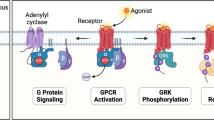Abstract
The finding that PDGF production is common in normal as well as transformed cells indicate that PDGF has a function in autocrine and paracrine stimulation of cells in several physiological and pathological conditions. The expression of mRNA for the two chains of PDGF are independently regulated. The fact that the different dimeric forms of PDGF have different functional effects, indicate that the cellular response to PDGF may be more complex than previously thought, and may involve binding to more than one receptor. The cellular effects ascribed to PDGF, growth stimulation, ruffling and chemotaxis, seems to be mainly associated with B chain containing dimers. The function of PDGF-AA remains to be elucidated.
Similar content being viewed by others
Author information
Authors and Affiliations
Additional information
Presented, by invitation, at the BACR/CRC/ICRF Symposium on 'Growth factors', London, December 1987.
Rights and permissions
About this article
Cite this article
Heldin, CH., Hammacher, A., Nistér, M. et al. Structural and functional aspects of platelet-derived growth factor. Br J Cancer 57, 591–593 (1988). https://doi.org/10.1038/bjc.1988.134
Issue Date:
DOI: https://doi.org/10.1038/bjc.1988.134
- Springer Nature Limited
This article is cited by
-
Elevated preoperative platelet distribution width predicts poor prognosis in Esophageal Squamous Cell Carcinoma
Scientific Reports (2019)
-
Down-regulation of platelet-derived growth factor-D expression blockades NF-κB pathway to inhibit cell proliferation and invasion as well as induce apoptosis in esophageal squamous cell carcinoma
Molecular Biology Reports (2013)
-
Platelet derived growth factor stimulates chondrocyte proliferation but prevents endochondral maturation
Endocrine (1997)
-
High chemotactic response to platelet-derived growth factor of a teratocarcinoma differentiated mesodermal cell line
In Vitro Cellular & Developmental Biology (1990)
-
Platelet-derived growth factor receptors in the kidney—Upregulated expression in inflammation
Kidney International (1989)




